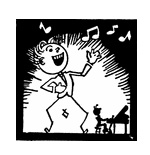
Why the Music Is So Bad
AND WHY IT WILL PROBABLY STAY THAT WAY
There has been an increasing groundswell of complaint lately about the inadequacies of music for the Novus Ordo Mass — the primitive quality of the music, the inappropriateness of style, the lack of sacred nature, and the near-heretical status of many hymn texts. A generation has grown up never hearing Latin, chant, polyphony, or traditional hymns in church. Much of this has been blamed on the Second Vatican Council. The Council, however, re-affirmed the use of Latin as the official language of the Roman rite, extolled the value of choir, stated that chant was to be given “pride of place,” and urged that musicians be well trained in seminaries and parishes. Pope John XXIII, who convened the Council, wrote an encyclical, Veterum Sapientia (1962), stressing the importance of Latin training in seminaries.
Pope Benedict XVI’s recent visit to the U.S. brought the great variance in “Catholic” music to the mainstream media. The music in the papal Mass in New York City, with its use of classical composers –Schubert, Brahms, Mozart, Palestrina — and chant, was in stark contrast to the pop-style hymns, merengue rhythms, and secular styles of music in the papal Mass in Washington, D.C. Indeed, during the D.C. Mass, EWTN’s Raymond Arroyo stated on the air that this was unusual music to choose for this Pope. He further added that Pope Benedict had written much about the liturgy and its music, and that it was evident that the people who selected the music for this Mass had not read a word of it. Commentators on other networks, however, repeated the press release they had been given that this Mass showcased “American multiculturalism.”
Why the discrepancy between the instruction and the practice?
There is the oft-repeated concern that, instead of reading the actual Vatican documents, Church leaders look to so-called experts who propound “the spirit of Vatican II,” which has little to do with the actual writings. But the problems run much deeper.
You May Also Enjoy
The question of musical excellence lingers. A primary objection to it is that it’s elitist or exclusive.
Esolen's purpose in 'Real Music' is to edify, to draw out for us the glory, the magnificence, the wonder, the beauty of the treasures available to us in word and music.
If liturgical music returns to praising and glorifying God, our focus has a better chance of returning to the Eucharist and the Word.

